Hildegard Peplau is a nurse theorist who created the Theory of Interpersonal Relations. Get to know Peplau’s theory and biography in this nursing theories study guide.
Biography of Hildegard E. Peplau
Hildegard Elizabeth Peplau (September 1, 1909 – March 17, 1999) was an American nurse who is the only one to serve the American Nurses Association (ANA) as Executive Director and later as President. She became the first published nursing theorist since Florence Nightingale.
Peplau was well-known for her Theory of Interpersonal Relations, which helped to revolutionize nurses’ scholarly work. Her achievements are valued by nurses worldwide and became known to many as the “Mother of Psychiatric Nursing” and the “Nurse of the Century.”
Early Life
Hildegard Peplau was born on September 1, 1909. She was raised in Reading, Pennsylvania, by her parents of German descent, Gustav and Otyllie Peplau. She was the second daughter, having two sisters and three brothers. Though illiterate, her father was persevering while her mother was a perfectionist and oppressive. With her young age, Peplau’s eagerness to grow beyond traditional women’s roles was precise. She considers nursing was one of few career choices for women during her time. In 1918, she witnessed the devastating flu epidemic that greatly influenced her understanding of the impact of illness and death on families.
Education
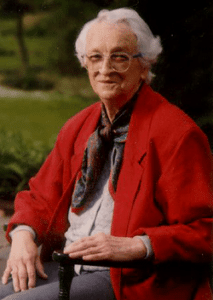
When the autonomous, nursing-controlled, Nightingale era schools came to an end in the early 1900s, schools then were handled by hospitals, and the so-called formal “book learning” was put down. Hospitals and physicians considered women in nursing as a source of free or inexpensive labor. Exploitation was widespread by nurse’s employers, physicians, and educational providers.
In 1931, she graduated from Pottstown, Pennsylvania School of Nursing. Peplau earned a Bachelor’s degree in interpersonal psychology in 1943 at Bennington College in Vermont. She studied psychological issues with Erich Fromm, Frieda Fromm-Reichmann, and Harry Stack Sullivan at Chestnut Lodge, a private psychiatric hospital in Maryland. Peplau held master’s and doctoral degrees from Teachers College, Columbia University, in 1947.
Career and Appointments of Hildegard Peplau
After graduating in Pennsylvania, Hildegard Peplau then worked as a staff nurse in her place and New York City. A summer position as a nurse for the New York University summer camp led to a recommendation for Peplau to become the school nurse at Bennington College in Vermont, where she earned a Bachelor’s degree in interpersonal psychology. Peplau’s lifelong work was largely focused on extending Sullivan’s interpersonal theory for use in nursing practice.
She served in the Army Nurse Corps and was assigned to the 312th Field Station Hospital from 1943-1945 in England, where the American School of Military Psychiatry was located. She met and worked with all the leading figures in British and American psychiatry. After the war, Peplau was at the table with many of these same men as they worked to reshape the mental health system in the United States through the passage of the National Mental Health Act of 1946.
“Nursing has made great progress from being an occupation to becoming a professional in the 20th. Century. As the 21st. Century approaches, further progress will be reported and recorded in Cyberspace – The Internet being one conduit for that. Linking nurses and their information and knowledge across borders – around the world – will surely advance the profession of nursing much more rapidly in the next century.”
– Hildegard Peplau
Peplau was certified in psychoanalysis by the William Alanson White Institute of New York City. In the early 1950s, she developed and taught the first classes for graduate psychiatric nursing students at Teachers College. Peplau was a member of the College of Nursing faculty at Rutgers University from 1954 until her retirement in 1974. She was a professor emeritus at the said university.
At Rutgers University, she created the first graduate-level program to prepare clinical specialists in psychiatric nursing. She was a prolific writer and was equally well known for her presentations, speeches, and clinical training workshops. Peplau vigorously advocated that nurses should become further educated to provide truly therapeutic care to patients rather than the custodial care that was prevalent in the mental hospitals of that era.
During the 1950s and 1960s, she supervised summer workshops for nurses throughout the United States, mostly in state psychiatric hospitals. In these seminars, she taught interpersonal concepts and interviewing techniques and individual, family, and group therapy. Peplau was an advisor to the World Health Organization and was a visiting professor at universities in Africa, Latin America, Belgium, and throughout the United States. A strong advocate for graduate education and research in nursing, Peplau served as a consultant to the U.S. Surgeon General, the U.S. Air Force, and the National Institute of Mental Health. She participated in many government policy-making groups.
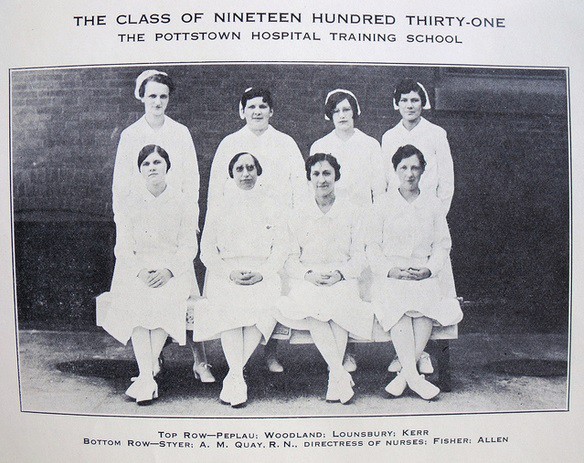
Peplau was devoted to nursing education at the full length of her career. After she retired from Rutgers, she served as a visiting professor at the University of Leuven in Belgium in 1975 and 1976. There she helped establish the first graduate nursing program in Europe.
She was the only nurse who served the ANA as executive director and later as president. She served two terms on the Board of the International Council of Nurses (ICN). And as a member of the New Jersey State Nurses Association, she actively contributed to the ANA by serving on various committees and task forces.
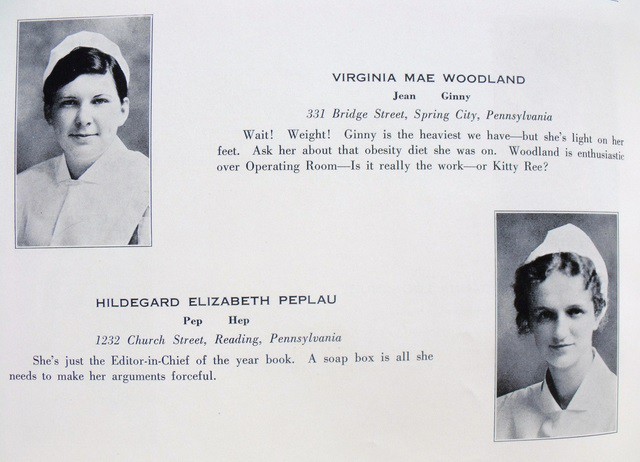
Her fifty-year career in nursing left an unforgettable mark on the field and the mentally challenged lives in the United States. During the peak of her career, she became the founder of modern psychiatric nursing, an innovative educator, advocate for the mentally ill, proponent of advanced education for nurses, Executive Director and then President of the ANA, and prolific author.
Like any other famous personalities, her life was often marked with controversy, which she faced with boldness, prowess, and conviction.
Interpersonal Relations Theory
In 1952, Hildegard Peplau published her Theory of Interpersonal Relations influenced by Henry Stack Sullivan, Percival Symonds, Abraham Maslow, and Neal Elgar Miller. Her theory is discussed further below.
Works
Some of Hildegard Peplau’s works include: Interpersonal Relations In Nursing: A Conceptual Frame of Reference for Psychodynamic Nursing, Interpersonal Theory in Nursing Practice: Selected Works of Hildegard E. Peplau, Basic principles of patient counseling: Extracts from two clinical nursing workshops in psychiatric hospitals, A Glance Back in Time: An article from Nursing Forum, On Semantics (psychiatric nursing): An article from Perspectives in Psychiatric Care, The Psychiatric Nurse–Accountable? To Whom? For What?: An article from Perspectives in Psychiatric Care and Psychotherapeutic Strategies: An article from Perspectives in Psychiatric Care.
Her book on her conceptual framework, Interpersonal Relations in Nursing, was completed in 1948. Publication took four additional years because it was groundbreaking for a nurse to contribute this scholarly work without a co-authoring physician.
Peplau’s original book from 1952 has been translated into nine languages and in 1989 was reissued in Great Britain by Macmillan of London. In 1989, Springer published a volume of selected works of Peplau from previously unpublished papers. Her ideas have, indeed, stood the test of time. The archives of her work and life are housed at the Schlesinger Library at Harvard University.
Awards and Honors
Peplau was acknowledged with numerous awards and honors for her contributions to nursing and held 11 honorary degrees. She was awarded honorary doctoral degrees from universities including Alfred, Duke, Indiana, Ohio State, Rutgers, and the University of Ulster in Ireland.
She was named one of “50 Great Americans” in Who’s Who in 1995 by Marquis. She was also elected fellow of the American Academy of Nurse and Sigma Theta Tau, the national nursing honorary society.
In 1996, the American Academy of Nursing honored Peplau as a “Living Legend.” She received nursing’s highest honor, the “Christiane Reimann Prize,” at the ICN Quadrennial Congress in 1997. This award is given once every four years for outstanding national and international contributions to nursing and healthcare. And in 1998, the ANA inducted her into its Hall of Fame.
Death
On March 17, 1999, Peplau died peacefully in her sleep at home in Sherman Oaks, California. She is survived by Dr. Leitia Anne Peplau and her husband, Dr. Steven Gordon, and their son, David Gordon of Sherman Oaks, CA; sister, Bertha Reppert (Byron), Mechanicsburg, PA; brother, John D. Forster (Dorothy), Reading, PA; niece, Dr. Carolynn Sears (Phillip) and children, Jessica and Jacob Sears, Pound Ridge, NY; niece Majorie Reppert, Jim Thorpe, PA; niece, Nancy Reppert, Mechanicsburg, PA; niece, Susanna Reppert (David Brill), Mechanicsburg, PA; niece, Karen Bently (William) and son, William, Sudbury, MA; and nephew, Carl Peplau, Hopewell Junction, NY.
The family requested that memorial contributions be made to the Peplau Research Fund through the American Nurses Foundation.
The need for a partnership between nurse and client is very substantial in nursing practice. This definitely helps nurses and healthcare providers develop more therapeutic interventions in the clinical setting. Through these, Hildegard E. Peplau developed her “Interpersonal Relations Theory” in 1952, mainly influenced by Henry Stack Sullivan, Percival Symonds, Abraham Maslow, and Neal Elgar Miller.
According to Peplau (1952/1988), nursing is therapeutic because it is a healing art, assisting an individual who is sick or in need of health care. Nursing can be viewed as an interpersonal process because it involves interaction between two or more individuals with a common goal. In nursing, this common goal provides the incentive for the therapeutic process in which the nurse and patient respect each other as individuals, both of them learning and growing due to the interaction. An individual learns when she or he selects stimuli in the environment and then reacts to these stimuli.
Hildegard Peplau’s Interpersonal Relations Theory
Hildegard Peplau’s Interpersonal Relations Theory emphasized the nurse-client relationship as the foundation of nursing practice. It emphasized the give-and-take of nurse-client relationships that was seen by many as revolutionary. Peplau went on to form an interpersonal model emphasizing the need for a partnership between nurse and client as opposed to the client passively receiving treatment and the nurse passively acting out doctor’s orders.
The four components of the theory are person, which is a developing organism that tries to reduce anxiety caused by needs; environment, which consists of existing forces outside of the person and put in the context of culture; health, which is a word symbol that implies a forward movement of personality and nursing, which is a significant therapeutic interpersonal process that functions cooperatively with another human process that makes health possible for individuals in communities.
The nursing model identifies four sequential phases in the interpersonal relationship: orientation, identification, exploitation, and resolution.
It also includes seven nursing roles: Stranger role, Resource role, Teaching role, Counseling role, Surrogate role, Active leadership, and Technical expert role.
Description
Hildegard E. Peplau’s theory defined Nursing as “An interpersonal process of therapeutic interactions between an individual who is sick or in need of health services and a nurse especially educated to recognize, respond to the need for help.” It is a “maturing force and an educative instrument” involving an interaction between two or more individuals with a common goal.
In nursing, this common goal provides the incentive for the therapeutic process in which the nurse and patient respect each other as individuals, both of them learning and growing due to the interaction. An individual learns when she or he selects stimuli in the environment and then reacts to these stimuli.
Assumptions
Hildegard Peplau’s Interpersonal Relations Theory’s assumptions are: (1) Nurse and the patient can interact. (2) Peplau emphasized that both the patient and nurse mature as the result of the therapeutic interaction. (3) Communication and interviewing skills remain fundamental nursing tools. And lastly, (4) Peplau believed that nurses must clearly understand themselves to promote their client’s growth and avoid limiting their choices to those that nurses value.
Major Concepts of the Interpersonal Relations Theory
The theory explains nursing’s purpose is to help others identify their felt difficulties and that nurses should apply principles of human relations to the problems that arise at all levels of experience.
Man
Peplau defines man as an organism that “strives in its own way to reduce tension generated by needs.” The client is an individual with a felt need.
Health
Health is defined as “a word symbol that implies forward movement of personality and other ongoing human processes in the direction of creative, constructive, productive, personal, and community living.”
Society or Environment
Although Peplau does not directly address society/environment, she does encourage the nurse to consider the patient’s culture and mores when the patient adjusts to the hospital routine.
Nursing
Hildegard Peplau considers nursing to be a “significant, therapeutic, interpersonal process.” She defines it as a “human relationship between an individual who is sick, or in need of health services, and a nurse specially educated to recognize and to respond to the need for help.”
Therapeutic nurse-client relationship
A professional and planned relationship between client and nurse focuses on the client’s needs, feelings, problems, and ideas. It involves interaction between two or more individuals with a common goal. The attainment of this goal, or any goal, is achieved through a series of steps following a sequential pattern.
Four Phases of the therapeutic nurse-patient relationship:
1. Orientation Phase
The nurse’s orientation phase involves engaging the client in treatment, providing explanations and information, and answering questions.
- Problem defining phase
- It starts when the client meets the nurse as a stranger.
- Defining the problem and deciding the type of service needed
- Client seeks assistance, conveys needs, asks questions, shares preconceptions and expectations of past experiences.
- Nurse responds, explains roles to the client, identifies problems, and uses available resources and services.
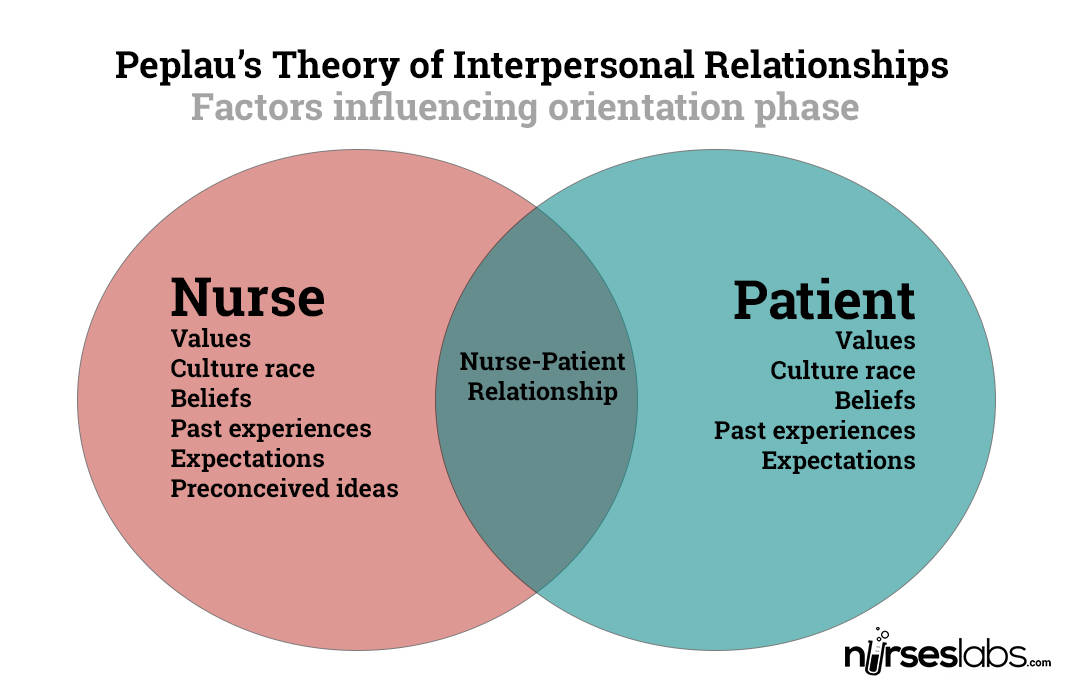
2. Identification Phase
The identification phase begins when the client works interdependently with the nurse, expresses feelings, and begins to feel stronger.
- Selection of appropriate professional assistance
- Patient begins to have a feeling of belonging and a capability of dealing with the problem, which decreases the feeling of helplessness and hopelessness.
3. Exploitation Phase
In the exploitation phase, the client makes full use of the services offered.
- In the exploitation phase, the client makes full use of the services offered.
- Use of professional assistance for problem-solving alternatives
- Advantages of services are used based on the needs and interests of the patients.
- The individual feels like an integral part of the helping environment.
- They may make minor requests or attention-getting techniques.
- The principles of interview techniques must be used to explore, understand and adequately deal with the underlying problem.
- Patient may fluctuate on independence.
- Nurse must be aware of the various phases of communication.
- Nurse aids the patient in exploiting all avenues of help, and progress is made towards the final step.
4. Resolution Phase
In the resolution phase, the client no longer needs professional services and gives up dependent behavior. The relationship ends.
- In the resolution phase, the client no longer needs professional services and gives up dependent behavior. The relationship ends.
- Termination of professional relationship
- The patient’s needs have already been met by the collaborative effect of patient and nurse.
- Now they need to terminate their therapeutic relationship and dissolve the links between them.
- Sometimes may be difficult for both as psychological dependence persists.
- The patient drifts away and breaks the nurse’s bond, and a healthier emotional balance is demonstrated, and both become mature individuals.
Subconcepts of the Interpersonal Relations Theory
Peplau’s model has proved greatly used by later nurse theorists and clinicians in developing more sophisticated and therapeutic nursing interventions.
The following are the roles of the Nurse in the Therapeutic relationship identified by Peplau:
Stranger: offering the client the same acceptance and courtesy that the nurse would respond to any stranger
Resource person: providing specific answers to questions within a larger context
Teacher: helping the client to learn formally or informally
Leader: offering direction to the client or group
Surrogate: serving as a substitute for another such as a parent or a sibling
Counselor: promoting experiences leading to health for the client such as expression of feelings
Technical Expert: providing physical care for the patient and operates equipment
Peplau also believed that the nurse could take on many other roles, but these were not defined in detail. However, they were “left to the intelligence and imagination of the readers.” (Peplau, 1952)
Additional roles include:
- Technical expert
- Consultant
- Health teacher
- Tutor
- Socializing agent
- Safety agent
- Manager of environment
- Mediator
- Administrator
- Recorder observer
- Researcher
Anxiety was defined as the initial response to a psychic threat. There are four levels of anxiety described below.
Four Levels of Anxiety
Mild anxiety is a positive state of heightened awareness and sharpened senses, allowing the person to learn new behaviors and solve problems. The person can take in all available stimuli (perceptual field).
Moderate anxiety involves a decreased perceptual field (focus on the immediate task only); the person can learn a new behavior or solve problems only with assistance. Another person can redirect the person to the task.
Severe anxiety involves feelings of dread and terror. The person cannot be redirected to a task; he or she focuses only on scattered details and has physiologic symptoms of tachycardia, diaphoresis, and chest pain.
Panic anxiety can involve loss of rational thought, delusions, hallucinations, and complete physical immobility and muteness. The person may bolt and run aimlessly, often exposing himself or herself to injury.
Interpersonal Theory and Nursing Process
Peplau’s Interpersonal Relations Theory and the Nursing Process are sequential and focus on the therapeutic relationship by using problem-solving techniques for the nurse and patient to collaborate on to meet the patient’s needs. Both use observation communication and recording as basic tools utilized by nursing.
| Assessment
| Orientation
|
| Nursing Diagnosis & Planning
| Identification
|
| Implementation
| Exploitation
|
| Evaluation
| Resolution
|
Analysis
Peplau conceptualized clear sets of nurse’s roles that every nurse can use with their practice. It implies that a nurse’s duty is not just to care, but the profession encompasses every activity that may affect the patient’s care.
The idea of a nurse-client interaction is limited to those individuals incapable of conversing, specifically those who are unconscious.
The concepts are highly applicable to the care of psychiatric patients considering Peplau’s background. But it is not limited to those sets of individuals. It can be applied to any person capable and has the will to communicate.
The phases of the therapeutic nurse-client are highly comparable to the nursing process, making it vastly applicable. Assessment coincides with the orientation phase; nursing diagnosis and planning with the identification phase, implementation as to the exploitation phase, and evaluation with the resolution phase.
Strengths
Peplau’s theory helped later nursing theorists and clinicians develop more therapeutic interventions regarding the roles that show the dynamic character typical in clinical nursing.
Its phases provide simplicity regarding the nurse-patient relationship‘s natural progression, which leads to adaptability in any nurse-patient interaction, thus providing generalizability.
Weaknesses
Though Peplau stressed the nurse-client relationship as the foundation of nursing practice, health promotion and maintenance were less emphasized.
Also, the theory cannot be used in a patient who doesn’t have a felt need, such as with withdrawn patients.
Conclusion
Peplau’s theory has proved greatly used to later nurse theorists and clinicians in developing more sophisticated and therapeutic nursing interventions, including the seven nursing roles, which show the dynamic character roles typical in clinical nursing. It entails that a nurse’s duty is not just to care, but the profession also incorporates every activity that may affect the client’s health.
However, the idea of nurse-client cooperation is found narrow with those individuals who are unfit and powerless in conversing, specifically those who are unconscious and paralyzed.
Studying Peplau’s Interpersonal Relations Theory of Nursing can be very substantial, especially to aspiring to be part of the profession. Knowing the seven nursing roles, future nurses can apply for different roles in different situations, which will guarantee their patients acquire the best care possible and ultimately speed along with treatment and recovery.
Recommended Resources
Recommended books and resources to learn more about nursing theory:
Disclosure: Included below are affiliate links from Amazon at no additional cost from you. We may earn a small commission from your purchase. For more information, check out our privacy policy.
- Nursing Theorists and Their Work (10th Edition) by Alligood
Nursing Theorists and Their Work, 10th Edition provides a clear, in-depth look at nursing theories of historical and international significance. Each chapter presents a key nursing theory or philosophy, showing how systematic theoretical evidence can enhance decision making, professionalism, and quality of care. - Knowledge Development in Nursing: Theory and Process (11th Edition)
Use the five patterns of knowing to help you develop sound clinical judgment. This edition reflects the latest thinking in nursing knowledge development and adds emphasis to real-world application. The content in this edition aligns with the new 2021 AACN Essentials for Nursing Education. - Nursing Knowledge and Theory Innovation, Second Edition: Advancing the Science of Practice (2nd Edition)
This text for graduate-level nursing students focuses on the science and philosophy of nursing knowledge development. It is distinguished by its focus on practical applications of theory for scholarly, evidence-based approaches. The second edition features important updates and a reorganization of information to better highlight the roles of theory and major philosophical perspectives. - Nursing Theories and Nursing Practice (5th Edition)
The only nursing research and theory book with primary works by the original theorists. Explore the historical and contemporary theories that are the foundation of nursing practice today. The 5th Edition, continues to meet the needs of today’s students with an expanded focus on the middle range theories and practice models. - Strategies for Theory Construction in Nursing (6th Edition)
The clearest, most useful introduction to theory development methods. Reflecting vast changes in nursing practice, it covers advances both in theory development and in strategies for concept, statement, and theory development. It also builds further connections between nursing theory and evidence-based practice. - Middle Range Theory for Nursing (4th Edition)
This nursing book’s ability to break down complex ideas is part of what made this book a three-time recipient of the AJN Book of the Year award. This edition includes five completely new chapters of content essential for nursing books. New exemplars linking middle range theory to advanced nursing practice make it even more useful and expand the content to make it better. - Nursing Research: Methods and Critical Appraisal for Evidence-Based Practice
This book offers balanced coverage of both qualitative and quantitative research methodologies. This edition features new content on trending topics, including the Next-Generation NCLEX® Exam (NGN). - Nursing Research (11th Edition)
AJN award-winning authors Denise Polit and Cheryl Beck detail the latest methodologic innovations in nursing, medicine, and the social sciences. The updated 11th Edition adds two new chapters designed to help students ensure the accuracy and effectiveness of research methods. Extensively revised content throughout strengthens students’ ability to locate and rank clinical evidence.
See Also
Recommended site resources related to nursing theory:
- Nursing Theories and Theorists: The Definitive Guide for Nurses MUST READ!
In this guide for nursing theories, we aim to help you understand what comprises a nursing theory and its importance, purpose, history, types or classifications, and give you an overview through summaries of selected nursing theories.
Other resources related to nursing theory:
- Betty Neuman: Neuman Systems Model
- Dorothea Orem: Self-Care Deficit Theory
- Dorothy Johnson: Behavioral System Model
- Faye Abdellah: 21 Nursing Problems Theory
- Florence Nightingale: Environmental Theory
- Hildegard Peplau: Interpersonal Relations Theory
- Ida Jean Orlando: Deliberative Nursing Process Theory
- Imogene King: Theory of Goal Attainment
- Jean Watson: Theory of Human Caring
- Lydia Hall: Care, Cure, Core Nursing Theory
- Madeleine Leininger: Transcultural Nursing Theory
- Martha Rogers: Science of Unitary Human Beings
- Myra Estrin Levine: The Conservation Model of Nursing
- Nola Pender: Health Promotion Model
- Sister Callista Roy: Adaptation Model of Nursing
- Virginia Henderson: Nursing Need Theory
References
- Hildegard Peplau (1909-1999) 1998 Inductee. (n.d.). . Retrieved July 1, 2014, from https://www.nursingworld.org/HildegardPeplau
- Sills, G. (n.d.). Hildegard Peplau. Nursing Theorist Homepage. Retrieved January 3, 2014, from https://publish.uwo.ca/~cforchuk/peplau/obituary.html
- George B. Julia, Nursing Theories- The base for Professional Nursing Practice, 3rd ed. Norwalk, Appleton & Lange.
- Peplau, H. E. (1952). Interpersonal relations in nursing. In George, J. (Ed.). Nursing theories: the base for professional nursing practice. Norwalk, Connecticut: Appleton & Lange.
- Peplau, H.E. (1988). The art and science of nursing: Similarities, differences, and relations. Nursing Science Quarterly, 1, 8-15. In George, J. (Ed.). Nursing theories: the base for professional nursing practice. Norwalk, Connecticut: Appleton & Lange.
External Links
- Peplau Research Fund – Supports research scholars in the ANF Nursing Research Grants Program.
- The Nurse Theorists – Hildegard Peplau Promo – A video interview with Peplau
- Interpersonal Relations In Nursing: A Conceptual Frame of Reference for Psychodynamic Nursing
- Interpersonal Theory in Nursing Practice: Selected Works of Hildegard E. Peplau
With contributions by Wayne, G., Ramirez, Q.
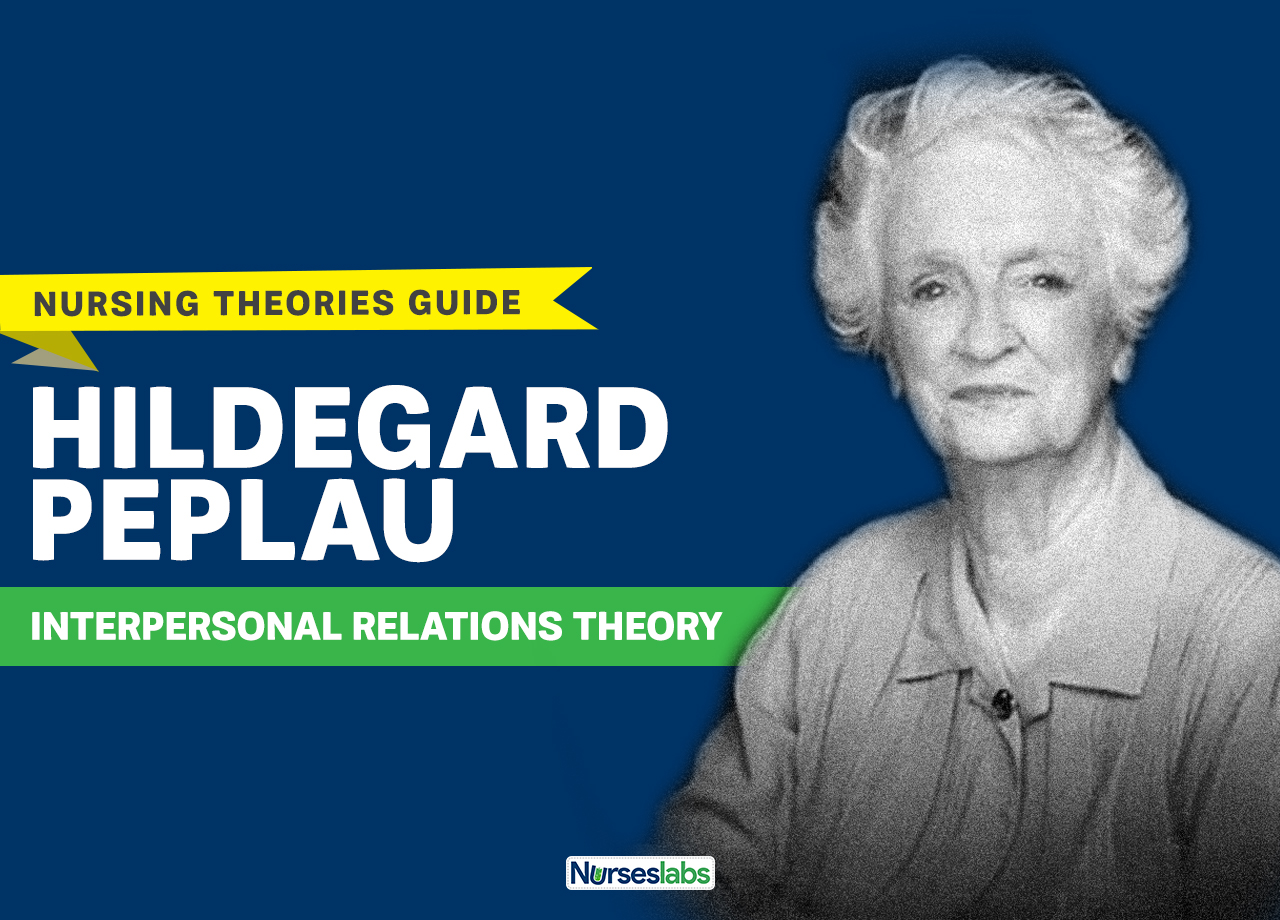
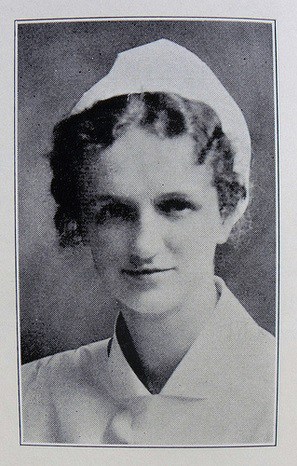
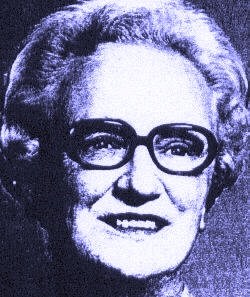
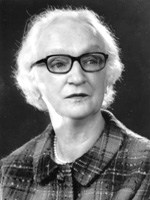

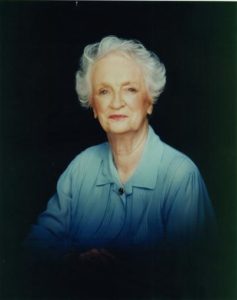
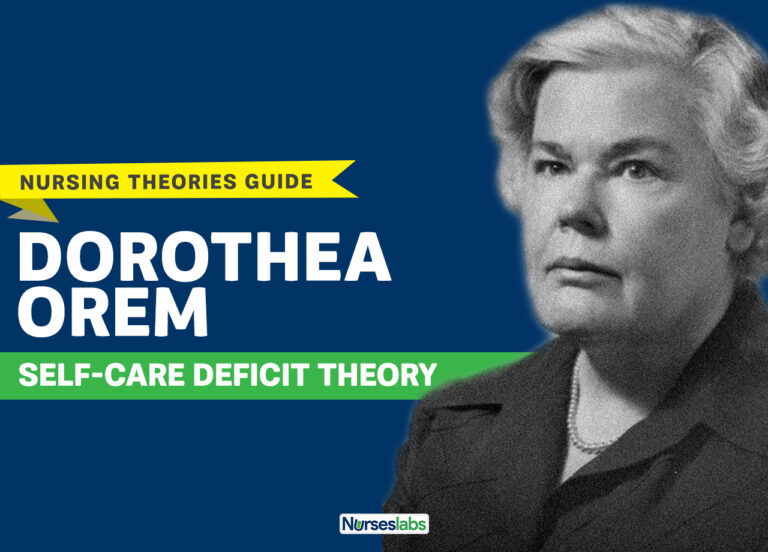

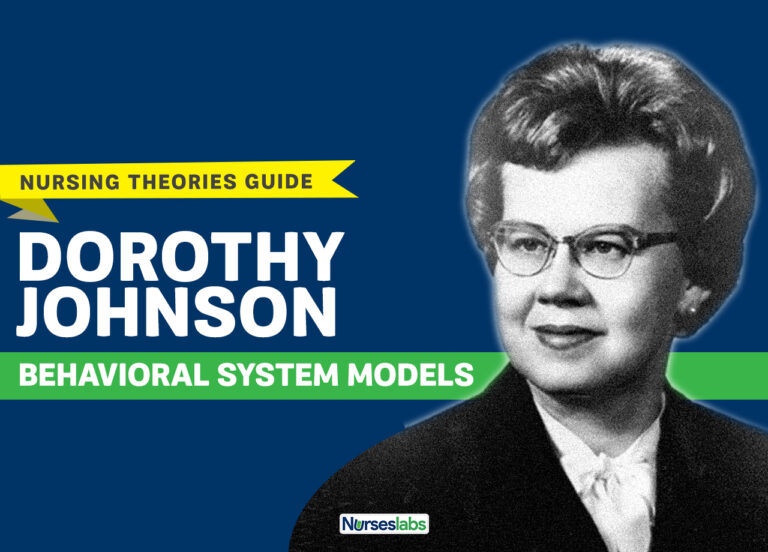
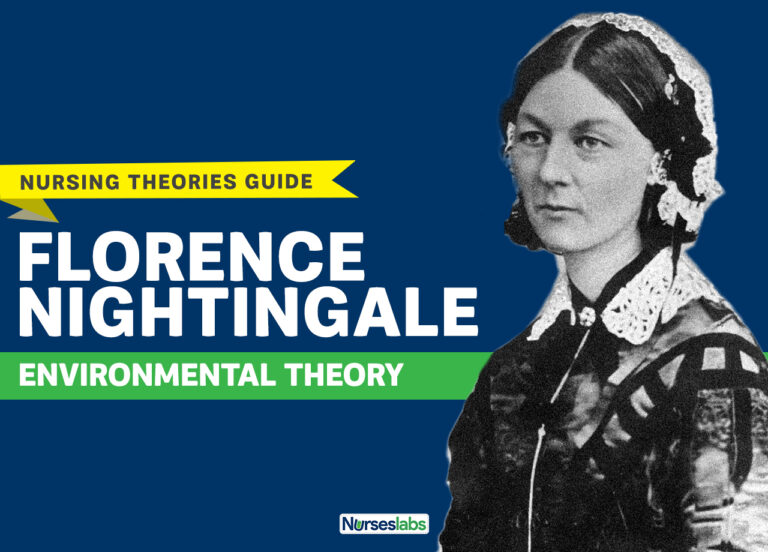


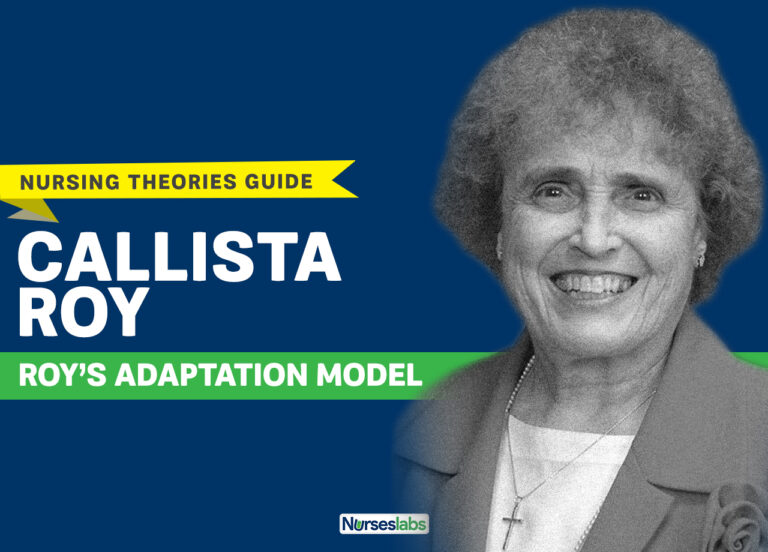
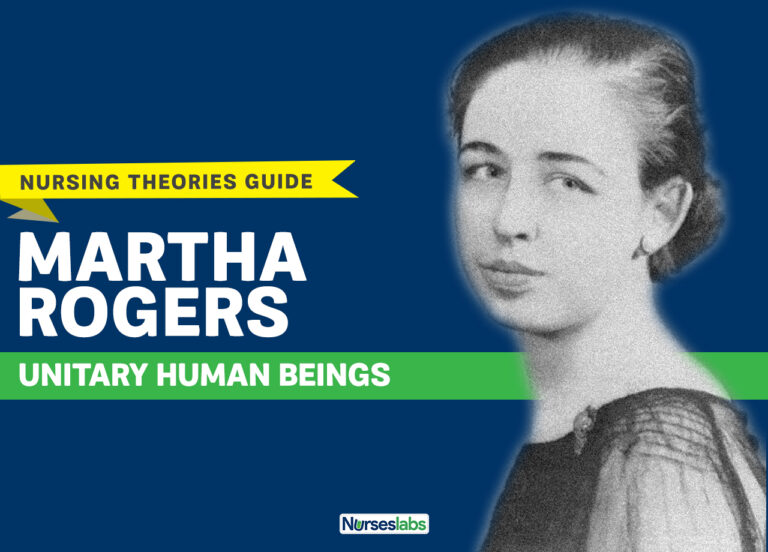


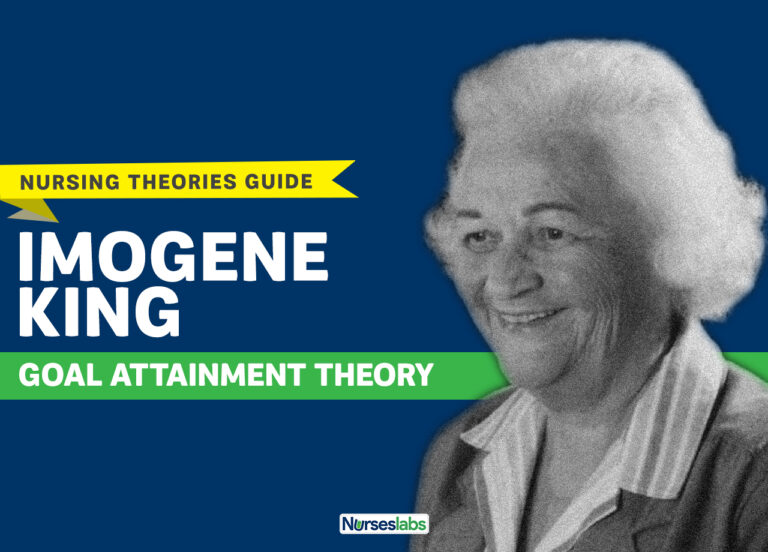

Leave a Comment